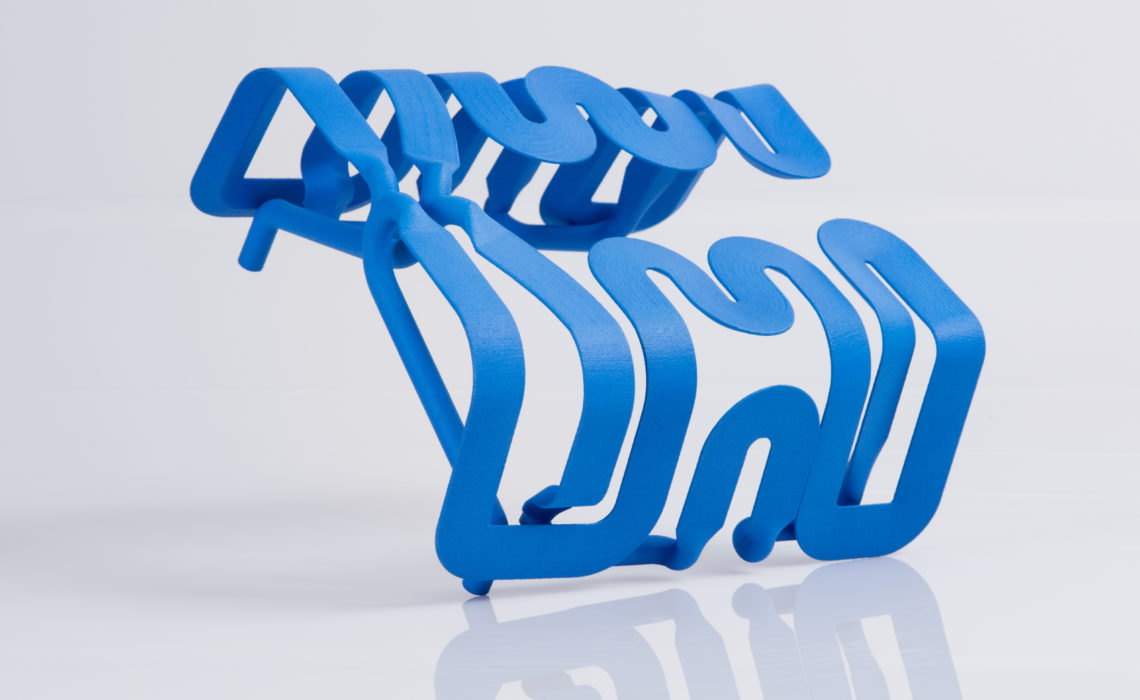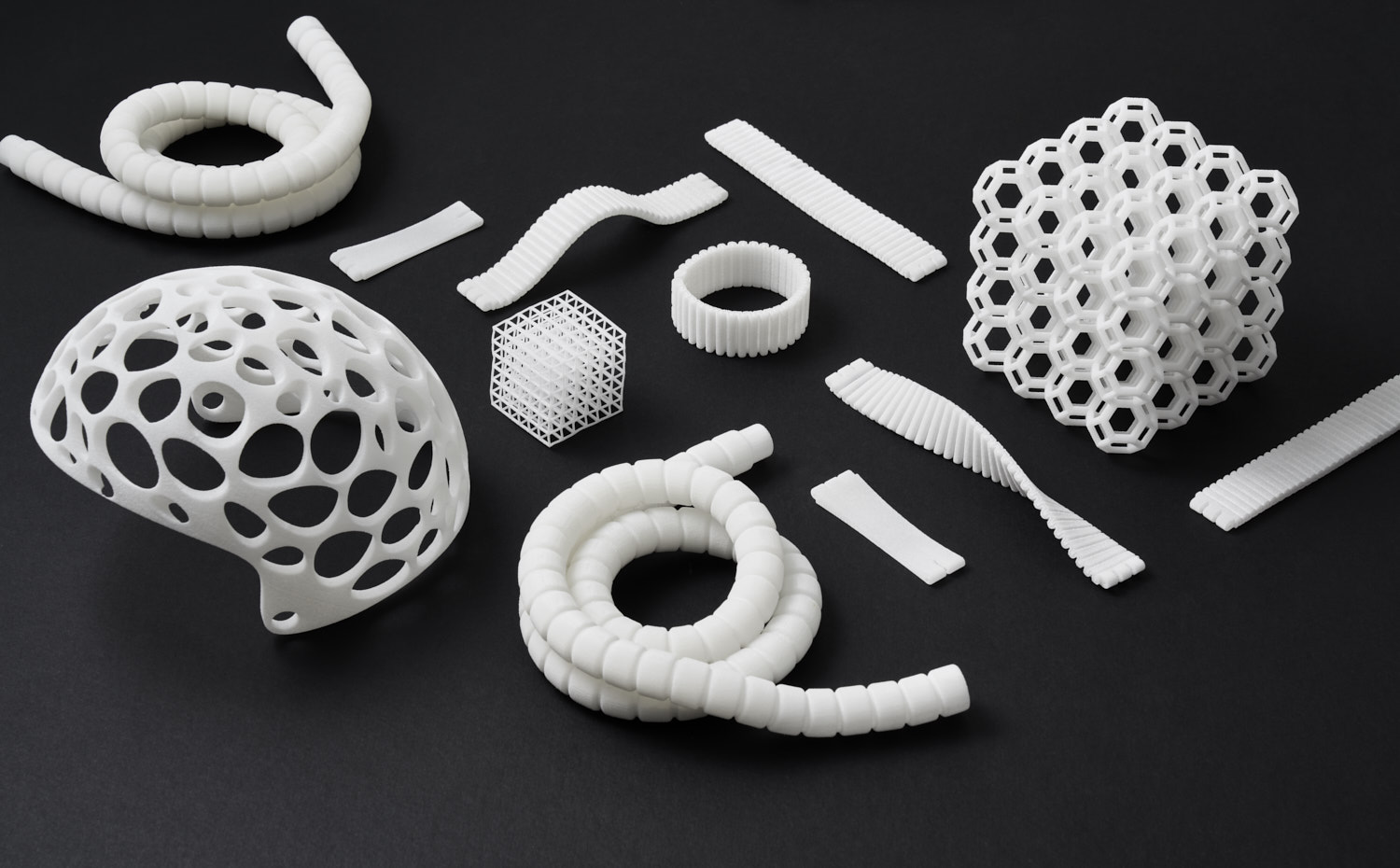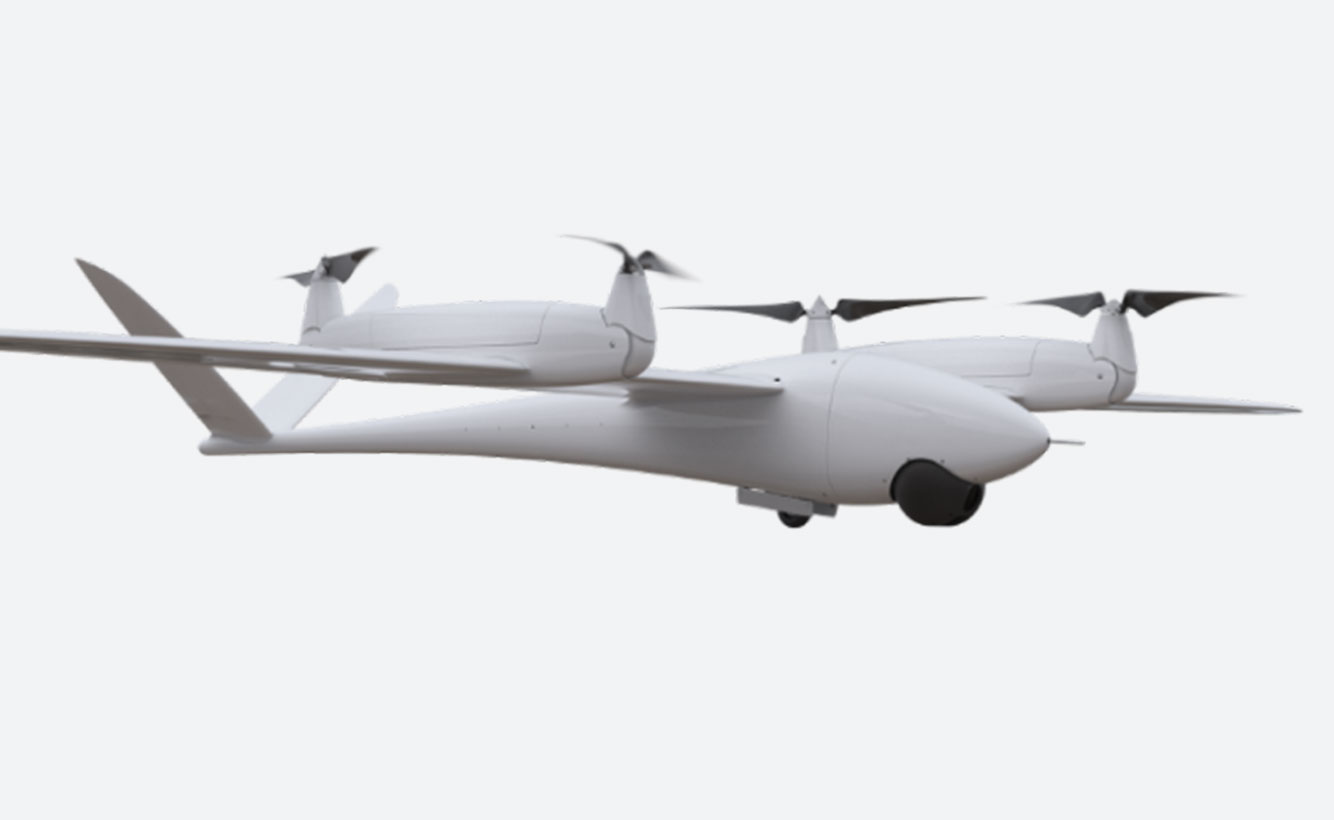
Check out the highlights from a recent webinar where Shapeways and EOS explain how a powerful combination of Selective Laser Sintering (SLS) and advanced materials deliver an incredible design toolbox for industrial customers.
In Increasing Your Production Power: Additive Manufacturing with EOS & Shapeways, the long-standing manufacturing partners and industry leaders outline the features of EOS materials, along with identifying the main benefits in developing products for additive manufacturing.
1. Selective Laser Sintering (SLS) is More Powerful than Ever

Relying on SLS 3D printing, EOS harnesses the power of powder-based technology targeted by lasers to solidify nylon particles, layer by layer, into the desired structure. Most SLS printers are large, and capable of printing an average of 500 to 1000 parts in a single build.
Most builds are made up of thousands of layers, resulting in detailed parts with intricate features. Shapeways uses popular nylon thermoplastics like Nylon 12 [Versatile Plastic] in partnership with EOS, along with other materials that according to Cary Baur, Senior Manager-Polymer Technology at EOS, are fairly common engineering plastics which translate well to other applications—including those that are also being used in traditional manufacturing methods like molding or machining.
One layer at a time is recoated at roughly 100 to 120 micron layers. Each layer of powder is deposited and then heated to just below the melting point.
“We use a directed laser in select areas to melt the materials and create the geometries that we want,” said Baur. “Essentially, we print in a two-dimensional method, but we do that in consecutive layers in the sense that we are building up a three-dimensional object. What this really does in terms of creating value is that it allows you to take a digital file and implement it in a way that gives you a huge design toolbox.”
2. Design Freedom is Huge
Freedom in design is boundless with SLS 3D printing. Supports are not required for this powder-based technology due to the bolstering effect of all the unsintered powder bunching up around parts during printing, stabilizing them throughout the process. This means that engineers don’t have to worry about factoring in support structures to the design process, and even better, production specialists don’t have to worry about fitting them in intricately to the print build—or risk the possibility of damaging parts during post-processing as supports are removed.
“We can 3D print lightweight parts that previously were very bulky because we couldn’t make custom lattices like we can now,” said Baur. “Now we can take those, reduce the mass dramatically, and also reduce material inputs.”
“There’s parts we used to have to machine and mold separately and assemble via different processes that all require more time and cost. Given our design freedom, now we can look at the process differently and design components to fit in with each other during printing.”
Complex parts can be made with better tolerances, greater efficiency, and may include dynamic, moving parts too.
3. The 3D Printing Journey Extends from the Concept to Reality
At the customer level, design begins with developing products for a specific application. After that, Shapeways is responsible for understanding the customer’s needs, revving up production, and providing solutions to scale for other manufacturers.
With the ability to eliminate tooling, 3D printing offers better cost optimization. Along with that comes great efficiency in the use of resources—namely, materials—as less are used in additive manufacturing as compared to subtractive, and much powder can be recycled in each build. Assemblies can be reduced in many cases, allowing for embedded functionality, and the ability to produce large parts all in one piece—meaning that quality and speed are improved, and there is also much less chance for error during production.
This is especially true during product development when many changes are continuing to take place. Projects are turned around swiftly, especially with the potential for quick feedback on virtual or tangible models, as well as haptic feedback.
“In comparison to the speed in 3D printing which takes hours or a few days, it can take months to create molds for traditional methods like injection molding,” mentioned Steve Weart, Director of Customer Success at Shapeways. “The time involved in production really adds up too if one or more changes need to be made.”
“Additive manufacturing makes more and more sense, especially in terms of being environmentally friendly. If we can make something locally, it really changes the game too.”
Shapeways customers are able to cater to the growing trend in demands from consumers for customized fit and customized treatment, whether in fashion or critical applications like medicine.
4. Low- to Medium-Volume Production Yields Great Efficiency
On demand 3D printing is a revolutionary concept, and one that is quickly gaining appeal and traction. With the ability to send Shapeways digital files and then set up customized 3D printing as needed whether for one part, low-batch production, or even mass production of parts, customers are able to avoid spending precious capital in buying their own 3D printing equipment and related materials, eliminate the need to keep inventory on hand or pay for warehouse space, and can even enjoy complete product fulfilment, as orders are shipped out directly in customized packaging.
“With a digital twin for parts on file, you can then just have a number of machines on standby ready to print parts on demand to keep company equipment up and running,” said Baur. “There is a very strong business case for converting as many aging parts as possible to digital files, so they are available when needed—and without having these massive warehouses full of aging parts and inventories just sitting there.”

SLS materials and technology are used in a wide range of applications, to include:
The automotive industry is a good example of customized products that are in demand for low-volume production—especially for luxury cars where there may be a target audience for complex interior parts that can be made much faster and more economically than with a traditional method like injection molding. For many different parts, weight can be reduced enormously, saving economically and in efficiency.
Medical devices like orthotics can also be made much more accurately for fit and functionality. Shape and density are improved with 3D printed products, with specific pressure-point areas and insoles that are designed for the weight and mass profile of the wearer. Performance is better, and customers are much less self-conscious due to more aesthetically pleasing choices. Being able to make a lightweight product is extremely important for orthotics too.
5. Customer Demand Drives Ongoing Product Improvement
Currently, Shapeways offers Nylon 12 [Versatile Plastic], Thermoplastic Urethane (TPU), and PA11. These materials are designed to offer flexibility in options for 3D printing, excellence in material properties, and ease in quality control and production.
“Nylon 12 is our highest-volume material on the market right now,” said Baur. “Nylon 11 also is very popular for applications that require more dynamic mechanical strain and more compliance.”
“A large part of our business is helping to identify the needs of our customers specific to an application,” said Baur. “If we don’t have a current material that meets customer needs, we often can make it, and often we will help enable our customers by working with Shapeways to then look at a material and a production process, with Shapeways filling the production need with the EOS material.”
About Shapeways
Contact Shapeways now to enjoy the benefits of advanced technology and materials for 3D printing with accuracy, complex detail, and no limits in terms of mass customization or single part orders. Shapeways has worked with over 1 million customers in 160 countries to make over 21 million parts! Read about case studies, find out more about Shapeways solutions, and get instant quotes here.

